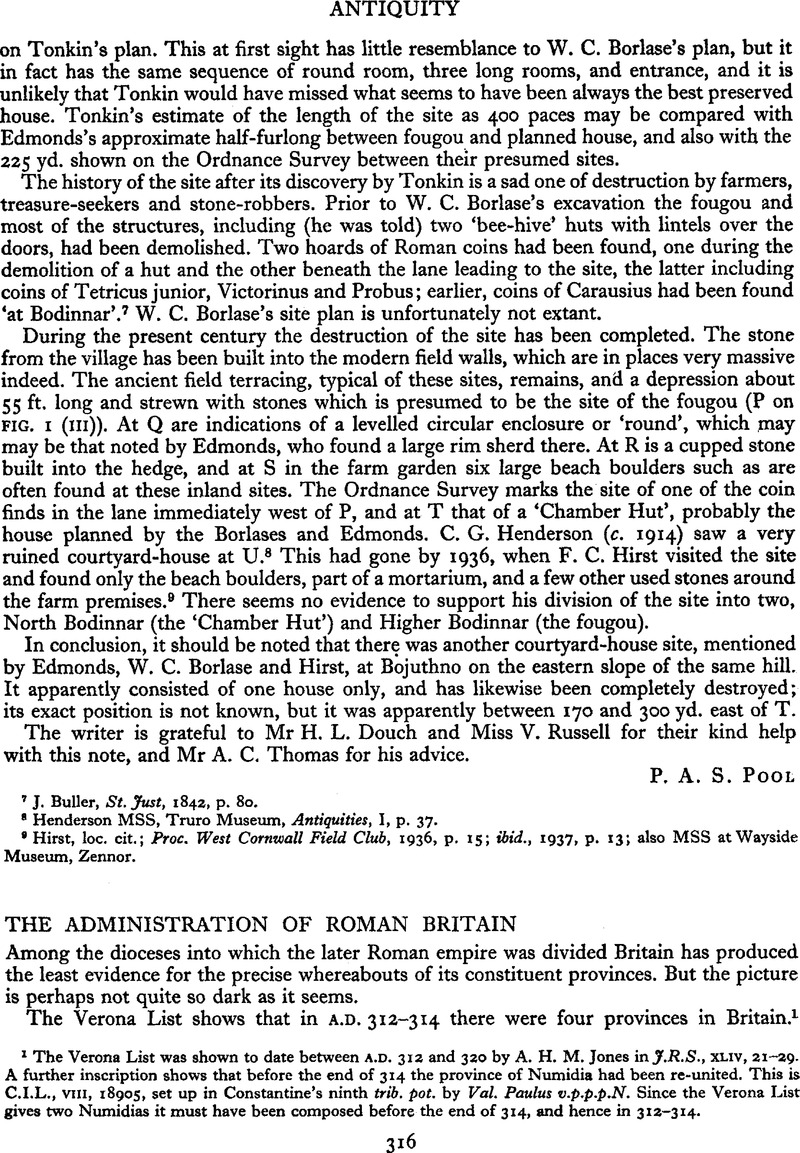Article contents
The Administration of Roman Britain
Published online by Cambridge University Press: 02 January 2015
Abstract

Information
- Type
- Notes and News
- Information
- Copyright
- Copyright © Antiquity Publications Ltd. 1961
References
1 The Verona List was shown to date between A.D. 312 and 320 by Jones, A. H. M. in J.R.S., XLIV, 21–29 Google Scholar. A further inscription shows that before the end of 314 the province of Numidia had been re-united. This is C.I.L., VIII, 18905, set up in Constantine's ninth trib. pot. by Val. Paulus v.p.p.p.N. Since the Verona List gives two Numidias it must have been composed before the end of 314, and hence in 312-314.
2 Mansi, , Conciliorum Nova et Amplissima Collectio, 11, 476–477 Google Scholar = Turner, C. H., Ecclesiae Occidentalis Monumenta Iuris Antiquissima, Tome 1, Fascicule II, Part II (1939, ed. Schwartz, ), 396–415 Google Scholar. The significance of this evidence was first pointed out to me some years ago by Dr J. P. C. Kent, when we attended Mr Browning's classes on the language of the early Church Councils, at University College London.
3 The provinces of Germania Prima, Maxima Sequanorum and Alpes Graiae et Poeninae are for some reason not recorded at all. (The provinces of Lugdunensis Tertia and Quarta of course did not yet exist in A.D. 314.)
4 Conveniently accessible in Seeck's edition of the Notitia Dignitatum, 261-274.
5 Each bishop attending this council was specifically allowed the use of the cursus publiais, along with two assistants ‘of the second rank’ ( Eusebius, , Hist. Eccl., x, 5, 23 Google Scholar). But the exinde seems clearly to separate Sacerdos and Arminius from the preceding bishop, as comparison with the wording of other parts of the list shows: its seems merely to mean ‘also from Britain’. (Only one bishop from the diocese of the Gauls had more than one assistant.) The text quoted is that of MS C, apparently the most reliable. For what it is worth, other traditions read Sacer episcopus for Sacerdos presbyter.
6 Londiniensium is no doubt a dittography from Londiniensi. This would be most likely to happen if the original were Lindensium. If, however, the reference was really to Camulodunum, most of what follows will still be valid.
7 The tombstone of Classicianus is the clearest indication that London was also the seat of the procurator.
8 R.C.H.M., , Roman London, 173, no. 14 and plate 61. No. 15 (fig. 76 and plate 60)Google Scholar in the same volume is the tombstone of a legionary centurion: the roll which the figure on the stone holds in his left hand may well indicate that he was princeps praetorii, the head of the governor's staff.
9 Acta proconsularia 5 (Corp. Script. Eccl. Latin., III, 3, p. cxiii). For these officials, cf. Domaszewski, , Die Rangordnung des römischen Heeres, 33 Google Scholar; Jones, A. H. M., J.R.S., xxxix, 44–45 Google Scholar.
10 III, 8, 2.
11 The best discussions of this thorny problem are those of Eric Birley in A.A.4 XI, 127-137 and C.W.2 LIII, 52-62.
12 E. Birley, A.A.4 XI, 131-133, gives the relevant evidence.
13 C.I.L., XIII, 3162. For the date, cf. J.R.S., XXVII, 247, no. 7Google Scholar.
14 Not. Dig. Oc., XI, 37 Google Scholar.
15 Jones, A. H. M., J.R.S., XLIV, 28–29 Google Scholar.
16 The development was necessarily somewhat different in the dioceses of Asia and Africa, where the proconsular provinces introduce a complication. In the diocese of Thrace the presence of Constantinople gave the province of Europa predominance, cf. Jones, A. H. M., J.R.S., XLIV, 27–28 Google Scholar. The rule applies to the diocese of Viennensis whether Aries or Vienne was the centre for the diocese (both were in the province of Viennensis, the first to receive a consularis, I.L.S. 1279) and to the diocese of the Spains, if the administrative centre was in Baetica (under a consularis by A.D. 357, Cod. Theod., IX, xlii, 3 Google Scholar, cf. C.I.L., II, 2206).
17 E.E. IX 997 = I.L.S. 5435.
18 Digest I, xviii, 15.
19 J.R.S., XIX, 214 Google Scholar = C.W.2 XXX, 200.
20 Not, Dig. Oc., I, 36 and v, 132Google Scholar.
21 ANTIQUITY, XXXIII, 170-182 = Problems of the Iron Age in Southern Britain (ed. Frere, S. S.), 1–16 Google Scholar.
22 I have no new suggestion to make here on the problem of Valentia, the new province created in A.D. 369, but two points may be noted. (1) The pottery evidence ( Gillam, J. P., Carnuntina (Römische Forschungen in Niederösterreich, Band III), 76 and map 10)Google Scholar ought now to kill finally the lingering notion that it lay to the north of Hadrian's Wall. (2) The title dux Britanniarum (as is clear from a study of 4th century titulature) implies that by the time of the Notitia Dignitatum his command covered more than one province, whereas, as argued above, at the time of the transfer to a dux, the command covered only one province. This suggests a subdivision of the early 4th century York province.
- 13
- Cited by

